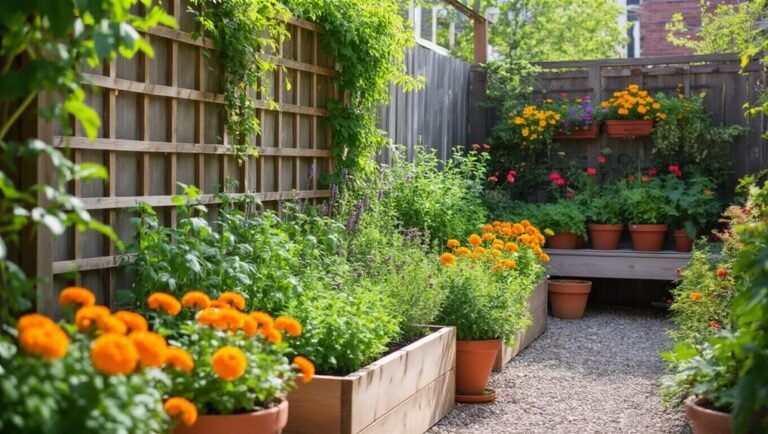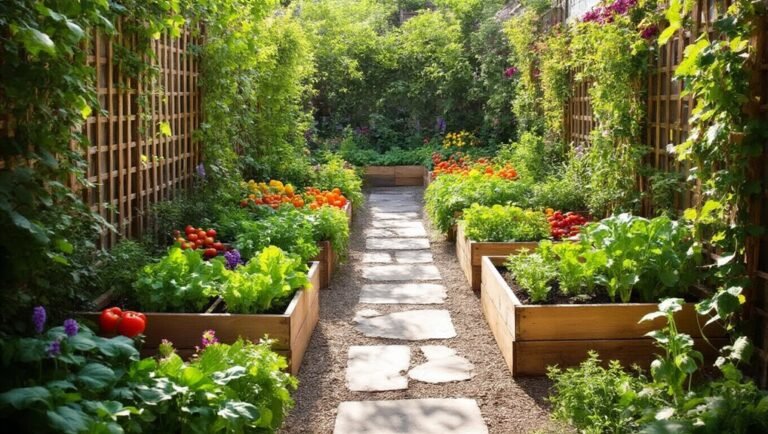If you’re starting a hydroponic garden, consider growing lettuce, basil, strawberries, and cucumbers. Lettuce is fast-growing and easy to manage, while basil thrives in warm environments and encourages bushy growth. Strawberries can bear fruit in a few months, and cucumbers are simple and refreshing, needing support as they grow. These plants adapt well to hydroponic systems, making them perfect for beginners. Stick around to find out tips and tricks for each plant’s success!
Key Takeaways
- Lettuce: Fast-growing and easy to manage, ideal for beginner hydroponics with a preference for cooler temperatures and specific pH levels.
- Basil: Thrives in warm conditions, quick to grow, and offers a rewarding harvest for beginners; regular trimming enhances growth.
- Strawberries: Produces delicious fruit in a few months; requires sufficient light and careful nutrient management for optimal results.
- Cucumbers: Fast-growing and refreshing; prefers warm environments and needs support for growth, making it a great choice for hydroponic systems.
- General Tip: Monitor nutrient levels and pH regularly to ensure healthy growth across all plants in your hydroponic garden.
Lettuce
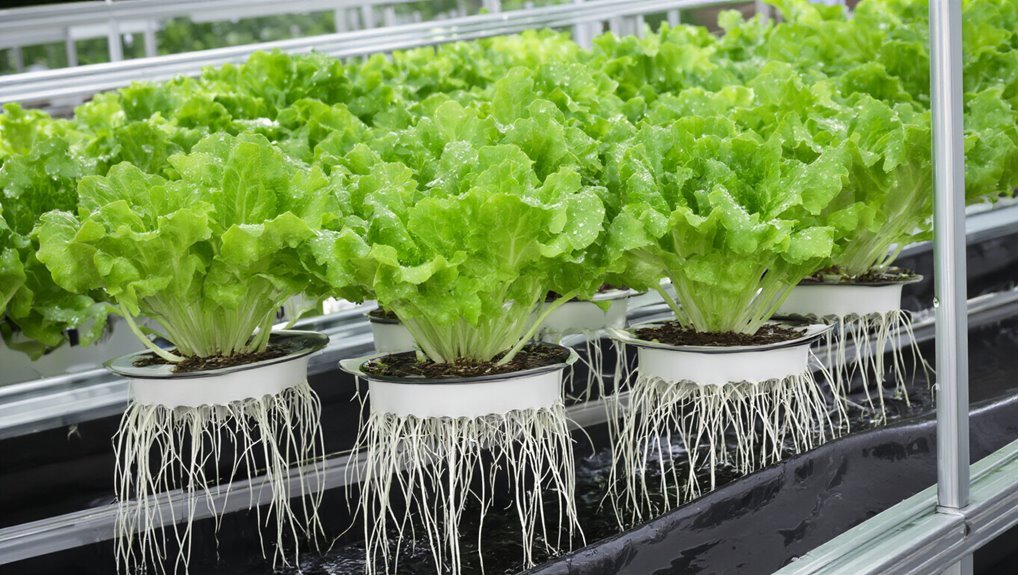
If you’re looking to dive into hydroponics, lettuce is one of the best plants to start with. It’s fast-growing, and you’ll typically see results in just a few weeks.
Plus, lettuce thrives in various hydroponic systems, whether you’re using deep water culture or nutrient film technique. You don’t need a lot of space, making it perfect for beginners. To ensure your lettuce flourishes, use hydroponic nutrient solutions specifically formulated for leafy greens.
Lettuce enjoys cooler temperatures, so keep your growing area between 60-70°F for optimal growth.
Make sure to monitor the pH level, aiming for around 5.5 to 6.5. Regularly check on nutrient levels, and you’ll be well on your way to harvesting crisp, fresh lettuce.
For those just starting out, it’s helpful to explore hydroponic gardening systems that are specifically designed for ease of use and efficiency. With minimal effort, you’ll enjoy a rewarding hydroponic experience!
Basil
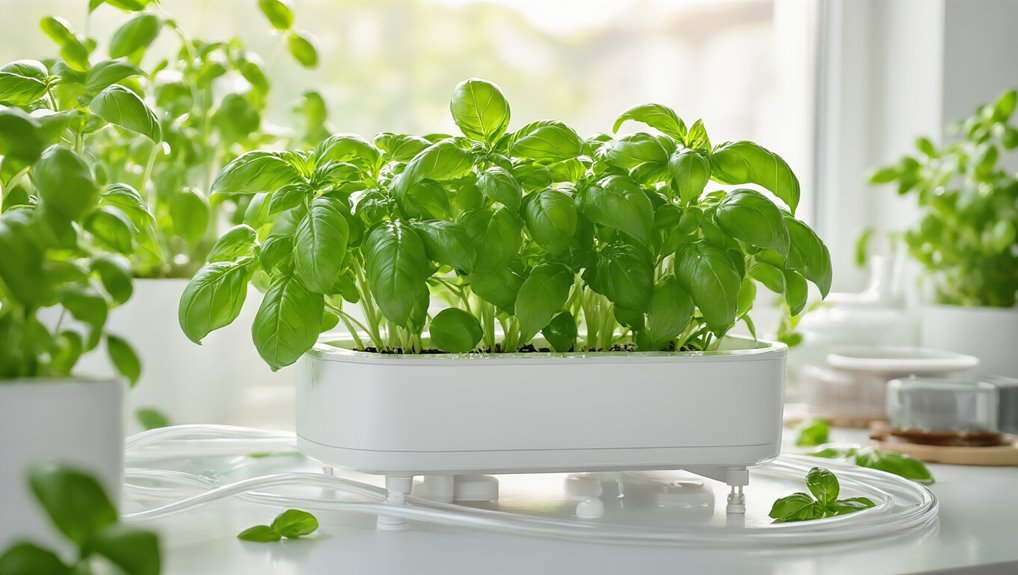
While you might think of basil as just a culinary herb, it’s an excellent choice for beginner hydroponics enthusiasts. This aromatic plant thrives in hydroponic systems and grows quickly, giving you a rewarding sense of accomplishment.
Basil prefers a warm environment, ideally around 70-80°F, and it loves bright, indirect light. You’ll want to ensure your nutrient solution is balanced, providing essential minerals. For beginners, plant fertilizer tablets can simplify feeding and promote healthy growth.
Basil can be grown from seeds or cuttings, so you have options. Make sure to monitor the pH level, keeping it between 5.5 and 6.5 for optimal growth. Regularly trimming your basil encourages bushier plants and prevents them from flowering too early.
Plus, you’ll enjoy fresh basil for your culinary creations! To help your basil thrive in a hydroponic setup, consider using a high-quality plant food that provides all the nutrients your plants need.
Strawberries
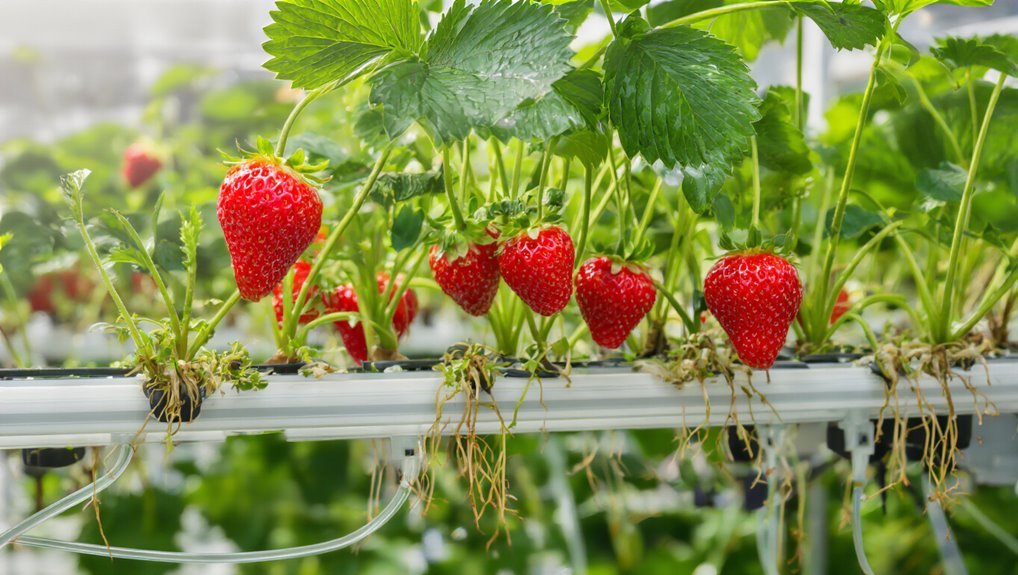
Strawberries are a delightful addition to any hydroponic garden, and they’re surprisingly easy to grow for beginners. They thrive in a nutrient-rich environment and can produce delicious fruit in just a few months. For gardeners looking to simplify maintenance, strawberries also do well in self-watering planters which help maintain consistent moisture levels.
Here are some tips to help you succeed:
- Choose the right variety: Opt for ever-bearing or day-neutral strawberries, as they tend to perform better in hydroponic systems.
- Maintain proper light: Ensure your plants receive at least 12-16 hours of light daily, using grow lights if necessary.
- Monitor nutrient levels: Keep an eye on your nutrient solution, adjusting pH and EC levels to ensure your strawberries get the nutrients they need.
To get your strawberries off to a strong start, consider using seed starting kits designed for optimal germination and early growth. With a little care, you’ll be enjoying fresh strawberries in no time!
Cucumbers
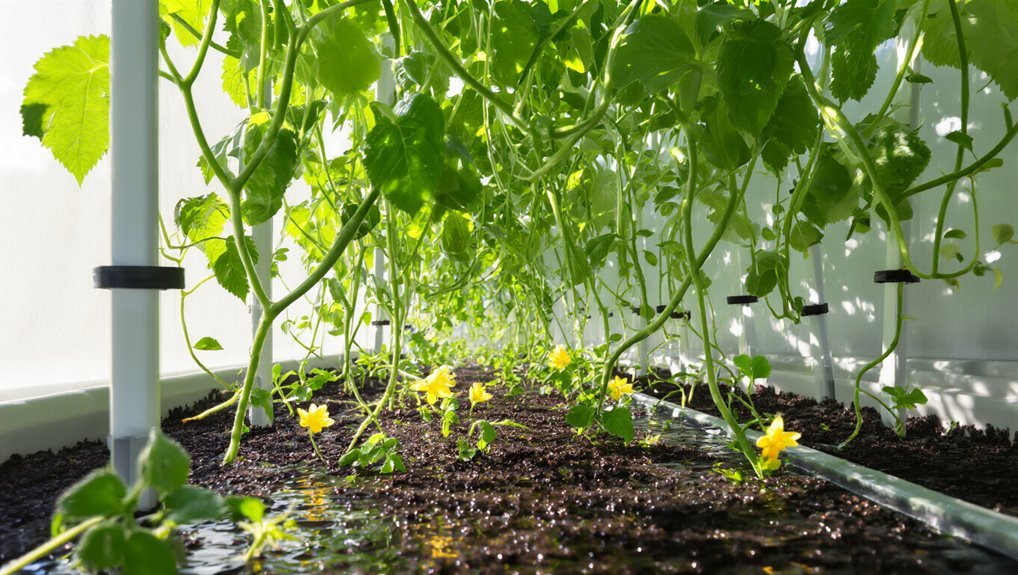
Cucumbers are a refreshing choice for your hydroponic garden, and they’re quite simple to grow. These fast-growing plants thrive in warm temperatures, making them perfect for indoor systems. For even more efficient watering, consider integrating drip irrigation systems into your setup to deliver nutrients directly to the roots. You’ll want to choose a nutrient-rich solution to ensure they flourish. Cucumbers need support as they grow, so consider using trellises or stakes to keep them upright.
Make sure to provide plenty of light—aim for at least 12 to 14 hours daily. Regularly check the pH level of your water, keeping it between 5.5 and 6.5 for optimal growth.
Watch for pests like aphids, and act quickly if you spot any. With a little care, you’ll soon enjoy crisp, homegrown cucumbers right from your hydroponic setup!
For traditional soil gardening, plant pots are a great option to support healthy root growth and enhance your indoor space.
Frequently Asked Questions
What Is the Initial Cost of Setting up a Hydroponic System?
The initial cost of setting up a hydroponic system can vary, but you’ll typically spend between $150 to $500. This covers equipment, nutrients, and seeds, so plan accordingly to ensure a successful start.
How Often Should I Check Ph Levels in My Hydroponic System?
You might think checking pH levels is a hassle, but it’s crucial. You should check them at least once a week, or more often if you notice any issues with your plants’ growth or health.
Can I Use Tap Water for My Hydroponic Plants?
You can use tap water for your hydroponic plants, but it’s best to let it sit for 24 hours to dissipate chlorine. Always check its pH and nutrient levels to ensure optimal growth.
What Type of Nutrients Do Hydroponic Plants Need?
Hydroponic plants need essential nutrients like nitrogen, phosphorus, and potassium, along with micronutrients such as iron and magnesium. You’ll want to use a balanced nutrient solution tailored for hydroponics to ensure healthy growth and development.
How Much Light Do Hydroponic Plants Require Daily?
Hydroponic plants typically need 12 to 16 hours of light daily. You should adjust the light intensity based on plant growth stages, ensuring they receive adequate but not excessive light for optimal development.
Conclusion
In the world of hydroponics, starting your journey with lettuce, basil, strawberries, and cucumbers is like planting seeds of confidence in your gardening abilities. Each plant is a stepping stone, nurturing your passion and curiosity. As you watch them thrive, you’ll discover that growing isn’t just about the harvest; it’s about cultivating patience and connection. So, dive in, embrace the process, and let your hydroponic garden bloom—a testament to your dedication and the beauty of nurturing life.

